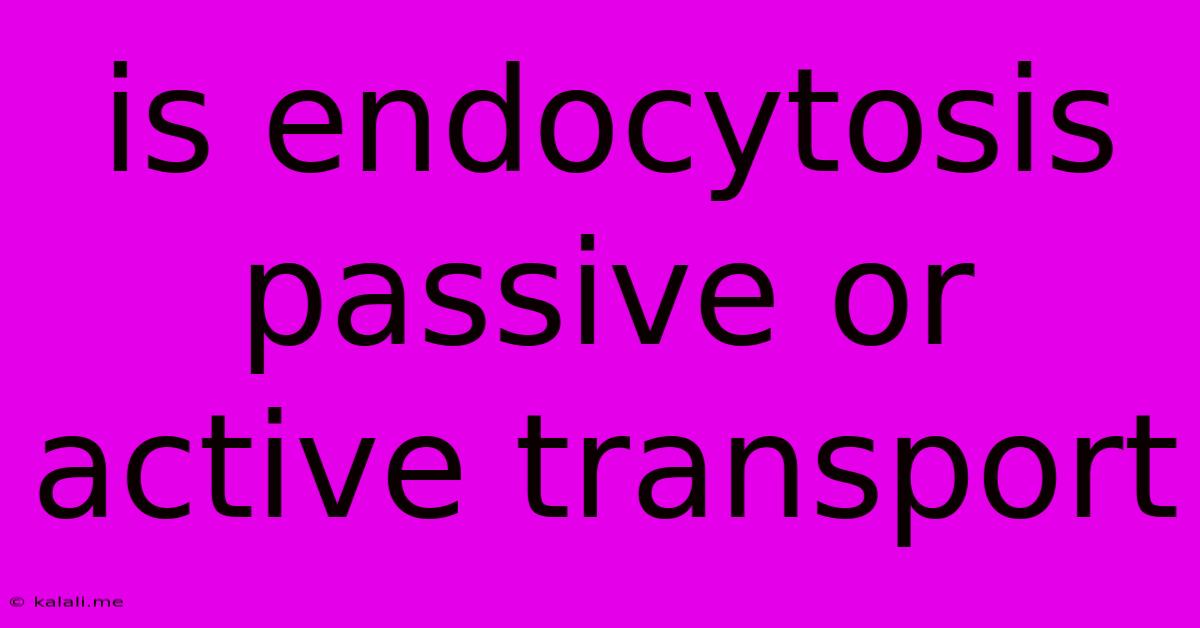Is Endocytosis Passive Or Active Transport
Kalali
May 10, 2025 · 3 min read

Table of Contents
Is Endocytosis Passive or Active Transport? Understanding Cellular Uptake
Endocytosis, the process by which cells absorb molecules by engulfing them, is a crucial cellular function involved in nutrient uptake, immune response, and signal transduction. But a common question arises: is endocytosis passive or active transport? The answer, as with many biological processes, is nuanced and depends on the specific type of endocytosis. This article delves into the mechanics of endocytosis, differentiating between its various forms and clarifying its energy requirements.
This article will explore the different types of endocytosis – phagocytosis, pinocytosis, and receptor-mediated endocytosis – and analyze their energy requirements to determine whether they fall under passive or active transport. Understanding this distinction is crucial for grasping the complexities of cellular function.
Understanding Passive vs. Active Transport
Before diving into the specifics of endocytosis, let's clarify the difference between passive and active transport. Passive transport doesn't require cellular energy (ATP) to move substances across the cell membrane. It relies on processes like diffusion, osmosis, and facilitated diffusion, driven by concentration gradients or electrochemical potentials. In contrast, active transport requires energy expenditure, usually in the form of ATP, to move substances against their concentration gradient, from an area of low concentration to an area of high concentration.
Types of Endocytosis and Their Energy Requirements
Endocytosis encompasses several distinct mechanisms, each with its own characteristics and energy requirements:
-
Phagocytosis ("cellular eating"): This process involves the engulfment of large particles, such as bacteria or cellular debris, by extending pseudopods (cell membrane projections) to form a phagosome. The phagosome then fuses with a lysosome, where the engulfed material is digested. Phagocytosis is an active process, requiring ATP for the formation and movement of pseudopods, and the subsequent fusion of vesicles. It’s a vital part of the immune system's defense mechanism.
-
Pinocytosis ("cellular drinking"): Pinocytosis is the uptake of fluids and dissolved substances through small vesicles formed by invaginations of the cell membrane. Unlike phagocytosis, it doesn't involve the engulfment of large particles. While the process itself doesn't require a large amount of energy for vesicle formation compared to phagocytosis, it still relies on the energy-dependent processes that maintain the cell membrane's fluidity and integrity. Therefore, pinocytosis is generally considered a form of active transport, although the energy requirement is less substantial than phagocytosis. The constant reshaping of the plasma membrane requires ATP.
-
Receptor-mediated endocytosis: This highly specific process involves the binding of ligands (e.g., hormones, proteins) to specific receptors on the cell surface. These receptor-ligand complexes cluster in coated pits, which invaginate to form coated vesicles. These vesicles are then transported to their destinations within the cell. The formation of coated pits and vesicles, like other forms of endocytosis, necessitates energy expenditure. Consequently, receptor-mediated endocytosis is an active transport process. Its specificity allows for efficient uptake of essential molecules.
Conclusion: Endocytosis – Primarily Active Transport
In summary, while the energy requirements vary across different types of endocytosis, the overall consensus is that endocytosis is primarily an active transport process. The formation of vesicles, the movement of these vesicles within the cell, and the maintenance of membrane integrity all require energy expenditure in the form of ATP. Although pinocytosis might seem less energy-intensive compared to phagocytosis, the fundamental requirement of membrane dynamics necessitates the involvement of active transport mechanisms. Understanding these nuances is key to appreciating the complexity and importance of endocytosis in various cellular functions.
Latest Posts
Latest Posts
-
How Many Square Yards In One Acre
Jul 02, 2025
-
What Is 2 3 Of 3 Quarts
Jul 02, 2025
-
Courtesy Is Cumbersome To Them That Know It Not
Jul 02, 2025
-
How Far Is 220 Yards On A Track
Jul 02, 2025
-
What Is The Shortest Chapter In The Bible
Jul 02, 2025
Related Post
Thank you for visiting our website which covers about Is Endocytosis Passive Or Active Transport . We hope the information provided has been useful to you. Feel free to contact us if you have any questions or need further assistance. See you next time and don't miss to bookmark.